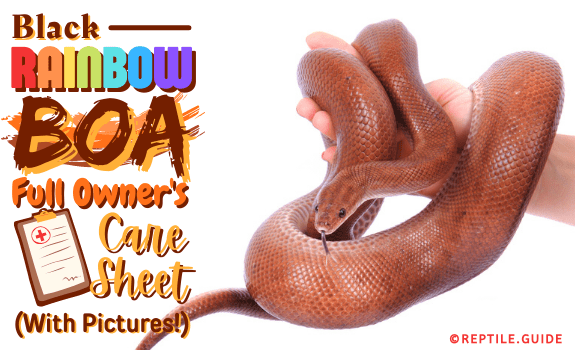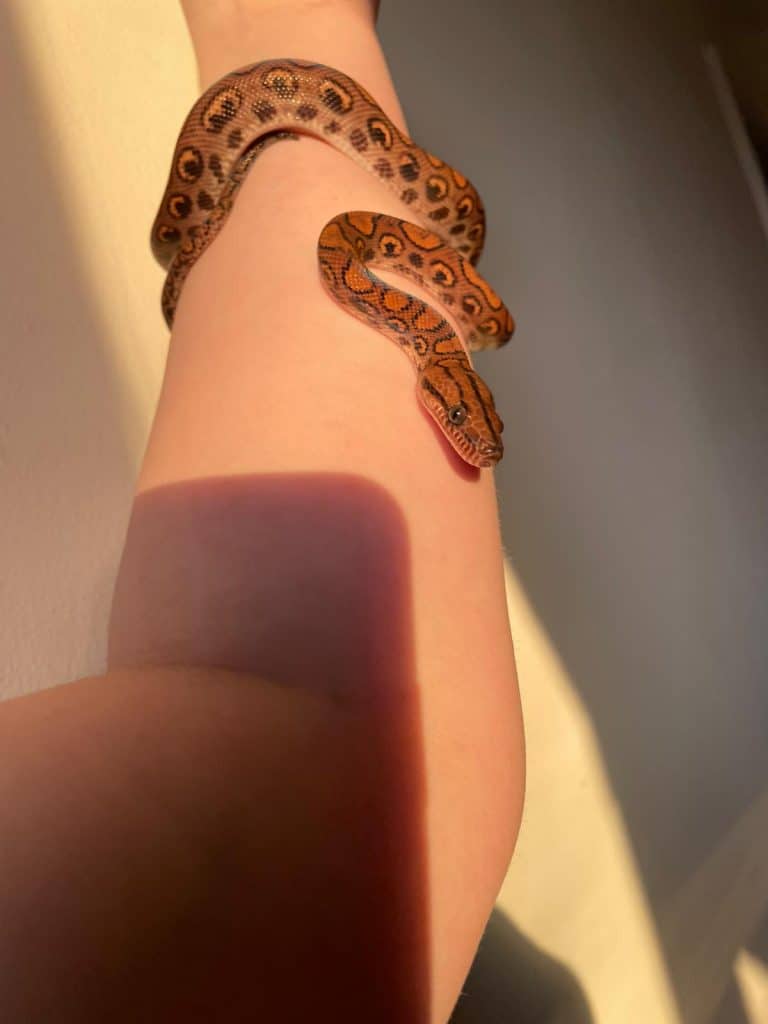Black rainbow boas don’t exist.
The black rainbow boa snake is neither a morph nor a species. The name is likely a result of confusion between a python and a boa.
No one knows for certain where the confusion started, but one thing is certain: No one has ever had a black rainbow boa.
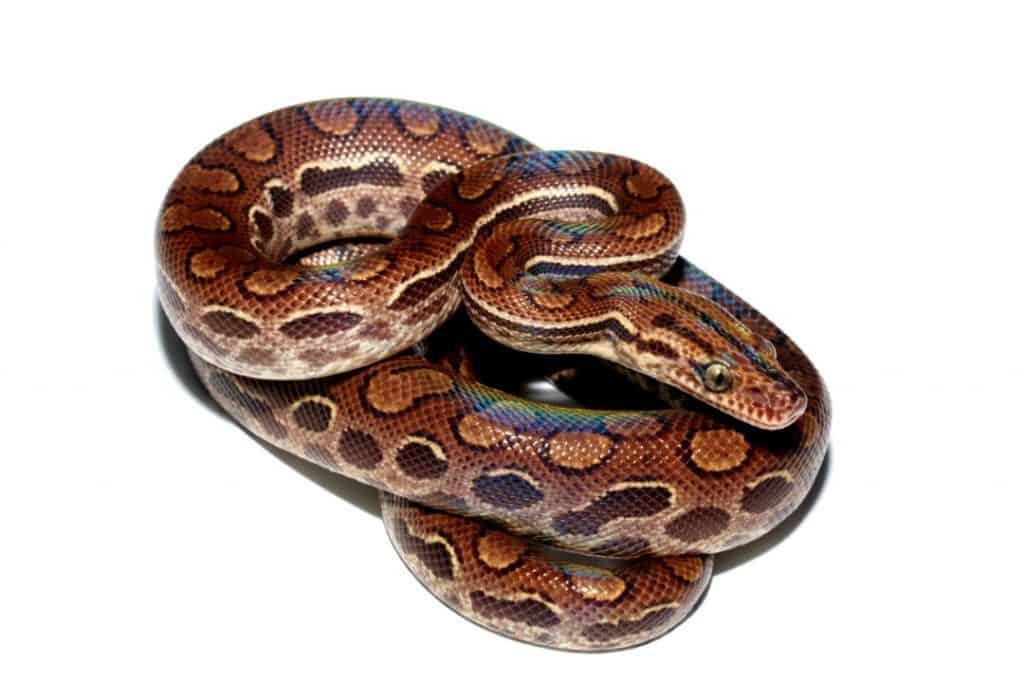
Image credit: u/darkemisary (via Reddit.com)
This article will tell you more about the story behind “black” rainbows, and share all the information you need before deciding if you want to keep actually existing rainbow boas.
In This Article
The Facts
- Black rainbow boas are a case of mistaken identity; the snake that’s making headlines is a rainbow python.
- Melanistic (black) rainbow boas haven’t been produced successfully.
- Some people refer to Brazilian rainbow boas as black rainbow boas, even though they’re a different color.
- The confusion about black rainbow boas may have come from the Esprito Santo rainbow boa, which starts as a black and white hatchling
- Another possible source of confusion is that many other snakes have a melanistic (all-black) morph.
- Captive-raised Colombian or Brazilian rainbow boas are docile and easy to care for.
- Brazilian rainbow boas, and their relatives, thrive on a diet of small mammals like rats and mice.
Are Black Rainbow Boas Real?
Black rainbow boas are not real.
No one knows where the confusion originates, but experts have a couple of theories:
- Species confusion
Recently, a beautiful black rainbow snake (not boa!) has been making headlines and generally taking the world by storm.
Some people believe that the confusion came from people who saw the snake and thought it was a type of rainbow boa. Both have rainbow-like sheens, so it’s a logical guess.
The snake in question, named MyLove, is a morph of the reticulated PYTHON, NOT a rainbow boa.
- Mistaken morphs
There are many different morphs of Brazilian and Colombian rainbow boas.
People who are familiar with species like ball pythons and corn snakes might have assumed that rainbow boas also have a melanistic morph. Sadly, that’s not the case.
While there are several species of rainbow boas, none of them are black.
- Wishful thinking
Some hobbyists believe that people have fallen in love with snakes like MyLove to the point where they’re waiting for someone to produce a black rainbow boa.
It’s plausible. Anyone who has seen the beauty of a rainbow boa can only dream of this snake in black.
- Hatchling confusion
Most true rainbow boas are brown with a strong iridescent sheen. Almost all of them have large black rings.
However, the Espirito Santo rainbow boa, Epicrates hygrophilus, starts as a black and white hatchling. It loses its color as it ages.
While these snakes finally adopt the yellowish coloration of the adults, it’s possible that someone thought they were a Brazilian rainbow.
We may never know exactly what sparked the confusion around the black rainbow boa, but it’s almost certainly a case of mistaken identity.
The species that people are referring to when they say “black rainbow boa” is probably the Brazilian rainbow boa.
In some circles, the name black rainbow boa gets used for the Brazilian rainbow, even though it only has black rings.
If you’d like to learn more about caring for rainbow boas, specifically the Brazilian rainbow boa, stick around.
We’ll share all the basic info you need if you decide to get one of these animals (once you overcome the disappointment of not getting a boa-in-black).
Want some more black snakes? Get to know the black ball python in this guide.
Brazilian Rainbow Boas Background Information
Brazilian rainbow boas, Epicrates cenchria, are one of five recognized species of rainbow boa.
The rainbow boa gets its name from a sheen on the snake’s surface scales. When the light reflects off the snake’s hide, it produces a rainbow-colored effect.
This mainly terrestrial species of boa’s native habitat is the humid forests and open savannas of the Amazon Basin, Suriname, Southern Venezuela, Guyana, and French Guiana.
Since the Brazilian rainbow boa is more terrestrial than other species in the genus, it’s not as attached to tree growth which is why it’s commonly found in open savannas.
These snakes are also commonly found in drainage areas and the humid woodland surrounding rivers and other watercourses in their distribution.
These snakes were first introduced to the pet trade in the late 1900s. In the 1980s especially, hundreds of Brazilian rainbow boas were imported from Brazil for sale as pets.
Size
While these snakes aren’t particularly large for constrictors, the males are significantly larger than the females.
Some of the largest rainbow boas on record reached lengths of nearly seven feet.
The average size for these snakes is five to six feet for males and four to five feet for females.
These snakes aren’t significantly larger than common pets like ball pythons and other similar animals, which makes them easy for a beginner to handle.
Breeding
The Brazilian rainbow boa is a polygynous species in the wild, which means that one male lives and breeds with multiple females.
They’re also ovoviviparous, meaning females give birth to live young.
Fun Fact: Unlike mammals, the snake merely retains the eggs in her body, and they hatch before getting “born” as live young.
Considering that each female gives birth to between two and 35 live young, and the male breeds with multiple females, the snakes can produce a lot of babies every year.
The gestation period lasts for around five months, and the hatchlings measure in at 15-20 inches long at birth.
Keeping Black Brazilian Rainbow Boas
There’s a lot of controversy about whether the Brazilian rainbow boa is a good pet for a beginner.
We’re of the view that, if you know what you’re getting into and raise your snake well, the rainbow boa is an excellent pet for a beginner.
Enclosure Setup
Since the Brazilian rainbow boa is easy to care for, it doesn’t have a lot of major requirements for its enclosure.
We’ll give you a shopping list after we discuss enclosure sizes.

Image credit: u/livingcode (via Reddit.com)
These beautiful brown boas aren’t arboreal, but they may climb trees. This produces an interesting paradox when you’re shopping for an enclosure.
The tank doesn’t need to be as tall as one for an emerald tree boa, for instance, but you’ll need a taller enclosure than for a corn snake or ball python.
Most keepers opt for an enclosure that’s six feet long, two feet wide, and two feet high. It’s a passable size for even a full-grown rainbow boa and creates a sense of security.
As promised, here’s a comprehensive list of items you need to get before you pick up your new snake:
- Two hides
- A water dish
- A hygrometer
- A 6′ x 2′ x 2′ enclosure
- Live or artificial plants
- Three high-quality thermometers
- A ceramic heat emitter, heat pad, or heat tape
- A high-quality substrate like coco coir or sphagnum moss
- Some sturdy branches or artificial vines for the snake to climb on
- A full-spectrum LED light or another type of full-spectrum lighting
- A thermostat for keeping temperatures in the ideal zone (for heat mats or tape only)
Water and Humidity
Rainbow boas come from an area with a high humidity level. If you want to keep these snakes healthy in captivity, then you need to replicate that.
For neonates (hatchlings), you need to provide a damp substrate and a humidity level of 90-100%.
An adult rainbow boa needs a humidity of between 75% and 85%. A reptile misting system can be useful for maintaining these levels.
Since it comes from a high rainfall area, the rainbow boa needs constant access to clean drinking water.
Give your Brazilian rainbow boa a large, flat water bowl that it can get into if it feels the need to. Since these snakes are mainly terrestrial, you can place the bowl on the ground.
Ensure that the water bowl stays full at ALL times since this will help maintain the humidity levels.
Decor and Environmental Enrichment
Unlike many boas, this snake is more terrestrial than arboreal and spends most of its time on the ground.
That doesn’t mean that your pet snake won’t appreciate the opportunity to climb, though.
When you’re setting up the enclosure, you can treat this snake like a semi-arboreal. Try to provide it with plenty of branches that it can climb on and twirl around.
Although this snake spends a lot of time on the ground, it usually lives in vegetated areas.
Your pet snake will benefit from the addition of both real and artificial plants to mimic the plant growth under trees.
Pro Tip: Planting real plants in your enclosure helps keep the humidity levels high.
Your snake will also need multiple hides to meet its needs. You should have a hide on the cool side, as well as a hide on the warm side.
This setup allows the snake to rest in the appropriate temperature zone, and adjust its body heat.
Diet
In captivity, most owners feed their rainbow boas a diet of small rodents.
The common practice is to start with pinkies and fuzzies (for baby snakes) then work up to larger rodents like young rats and full-grown mice.
If you could find a baby black rainbow boa, you’d follow a similar feeding scheme.
Considering their diet in the wild, several other prey items might be useful in captivity. While you may not want to add birds to their diet, you could try:
- Feeder lizards like geckos and anoles
- Feeder fish
- Feeder amphibians
Most of the rainbow boa species have a strong feeding response, which means that they’ll easily accept many different prey items.
Since they’re not picky, it’s easier to provide a varied diet for these snakes.
If the Brazilian rainbow boa is your first snake, you might want to stick to the traditional diet of rats and mice.
Heating
As with most snakes, the Brazilian rainbow boa benefits from a temperature gradient.
Snakes can’t produce their own body heat, so they moderate their temperatures by moving from one temperature zone to the next.
There are four temperature zones that you need to keep an eye on in your rainbow boa enclosure. I’ll list them below, and which temperatures you should keep them at:
- Ambient night-time temperatures: 75-80°F
- Ambient daytime temperature: 80-85°F
- Cool side: 75-80°F
- Hot side:80-85°F
The best way to keep track of the temperatures in your rainbow boa enclosure is to have three thermometers:
- One on the warm side
- One on the cool side
- One in the middle
This setup allows you to monitor the temperatures in all parts of the tank, and ensure that it stays in the optimum range.
Since the rainbow boa is terrestrial, you have several heating options:
- Ceramic heat emitter – A special type of lightbulb that creates heat rather than light. They’re effective, but you need to place a wire cage around the bulb so the snake can’t burn.
- Heat pads – One of the easiest ways to heat an enclosure. Simply attach the pad to the glass, and use a thermostat to moderate the temperatures.
- Heat tape – Works the same way as a heating pad, but comes in the shape of tape.
Any of these heating methods are effective, and it all depends on what you’re comfortable with using. We suggest heat pads since they’re the easiest to control.
Lighting
Unlike some reptiles, the Brazilian rainbow boa doesn’t require UVB lighting to thrive.
They require a realistic photoperiod, though, so consider buying something like a full-spectrum LED setup.
These snakes are nocturnal, so their lights MUST stay off at night.
Your rainbow boa will thrive if given a 12/12 light period: 12 hours with the lights on (to simulate daylight), and 12 hours with the light off (to replicate nighttime).
Substrate
The best substrate for a humidity-loving species like the rainbow boa is one that maintains moisture for extended periods.
Paper products, like paper towels, are a popular choice for young snakes. While they work well for young snakes, since they’re easy to replace, they tend to dry out quickly.
You’ll need to mist the paper towels multiple times a day, but they’re easy to replace regularly and the young snakes can’t inadvertently swallow some.
Since they dry out so quickly, they’re not an ideal choice long-term. Here are some excellent substitutes for an older snake:
All of these options are readily available, and maintain moisture levels for longer. Check out our article about ball python substrates for more detailed information about each type.
Tips For New Keepers
When you’re picking up your new rainbow boa, it’s natural to be a bit nervous. . We’ve gathered some handy hints and tips to help ease you into that first period.
- Ensure that you don’t place the rainbow boa enclosure in front of windows or ventilation shafts.
The enclosure should be out of direct sunlight and away from drafts.
This ensures that the only things affecting the temperature and humidity are the ones you intentionally included. - Set up the entire enclosure with all its equipment at least one week before picking up the snake.
This gives you time to monitor the temperature zones and humidity and ensure that everything is working as it should. - Try not to move the enclosure around for the first two to four weeks after the snake arrives. If at all possible, place the enclosure in its permanent home before getting the snake.
This approach will give the snake time to adapt before you move its home. - For the first few days, allow the snake to simply settle in. Don’t move around too much, so they can get used to the changes in the scent and feel of their surroundings.
- Handle young snakes regularly so that they can grow into docile, well-adjusted adults. Socialization at a young age is vital if you want a peaceful adult rainbow boa.
Handling young snakes regularly is important if you want a friendly snake.
Image credit: u/maskedopheo (via Reddit.com) - Don’t handle your snake within 24 hours of it having a meal, as this can negatively affect the snake’s digestive process.
- Never handle a snake while it’s shedding or after you’ve handled rats and mice. Your rainbow boas senses are slightly dulled during shedding, and it might not recognize you.
If it smells rats and mice on you it might mistake your hand for food.
Black Rainbow Boa Price
Since there’s no black morph of the rainbow boa, you can’t buy one.
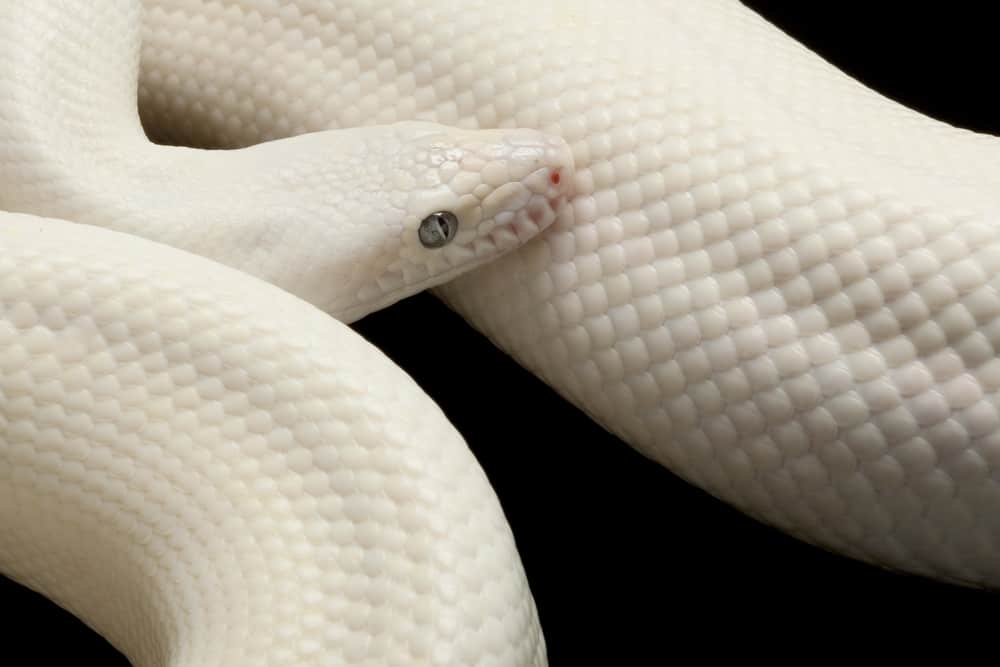
There are many existing morphs of the Brazilian rainbow boa to choose from though. Here’s a glance at some of the prices:
- Normal – $300
- Caramel Albino – $2500
- Hypo – $500
- Leucistic – $500
In the future, a breeder might manage to produce a melanistic or black brazilian rainbow boa.
If they do, the black rainbow boa price would probably start high and become more affordable as more breeders bred them.
What Do Black Rainbow Boas Eat?
If black rainbow boas existed, they’d probably eat the same thing that other rainbow boas eat.
In their native habitat, the rainbow boa eats small mammals, rodents, and probably small birds and lizards.
Some scientists believe that they also eat aquatic animals like fish and amphibians.
In captivity, these animals mainly eat rodents of varying sizes. They start on babies like pinkies and fuzzies, and the size increases as they age.
Considering that their diet consists of more than small mammals in the wild, you might be able to feed your rainbow boa a more diverse diet.
Additional foods that your rainbow boa might accept include:
- Feeder anoles and geckos
- Feeder fish
- Feeder amphibians
Until you get the hang of keeping a rainbow boa, it’s probably best to stick to the general diet of captivity: small rodents.
Are Rainbow Boas Poisonous?
Snakes aren’t poisonous. Poisonous things can kill you if you eat them or drink them, so unless you eat the venom gland of a snake, you don’t have to worry about poisonous snakes.
The real question is, are rainbow boas venomous? The answer is no to that question as well. Like most constrictors, the rainbow boa suffocates its prey to death.
Constrictors do not need venom since they wrap themselves around their prey and squeeze till it stops breathing.
While the Brazilian rainbow boa doesn’t have venom, that doesn’t automatically mean you won’t suffer ill effects if it bites you.
In some cases, people are allergic to the proteins in a snake’s venom. If you get bitten, it’s a good idea to get checked out by a medical professional.
Are Rainbow Boas Dangerous?
As we mentioned above, Rainbow boas are constrictors that have no venom. They’re NOT dangerous to humans.
Unless you have an allergy to the proteins in its saliva and suffer a relatively rare bite, a rainbow boa isn’t a threat to you.
A Brazilian rainbow boa may sometimes instinctively try to constrict you. Thanks to their small size, this likely means little more than some heavy pressure on your arm.
At a maximum size of just under seven feet, rainbow boas aren’t dangerous.
These snakes shouldn’t be allowed to roam free (unsupervised) near young babies, though. A snake is a snake, and anything small and warm might be mistaken for a food source.
Are Rainbow Boas Aggressive?
By nature, captive-bred Brazilian rainbow boas are docile snakes and don’t generally display aggression.
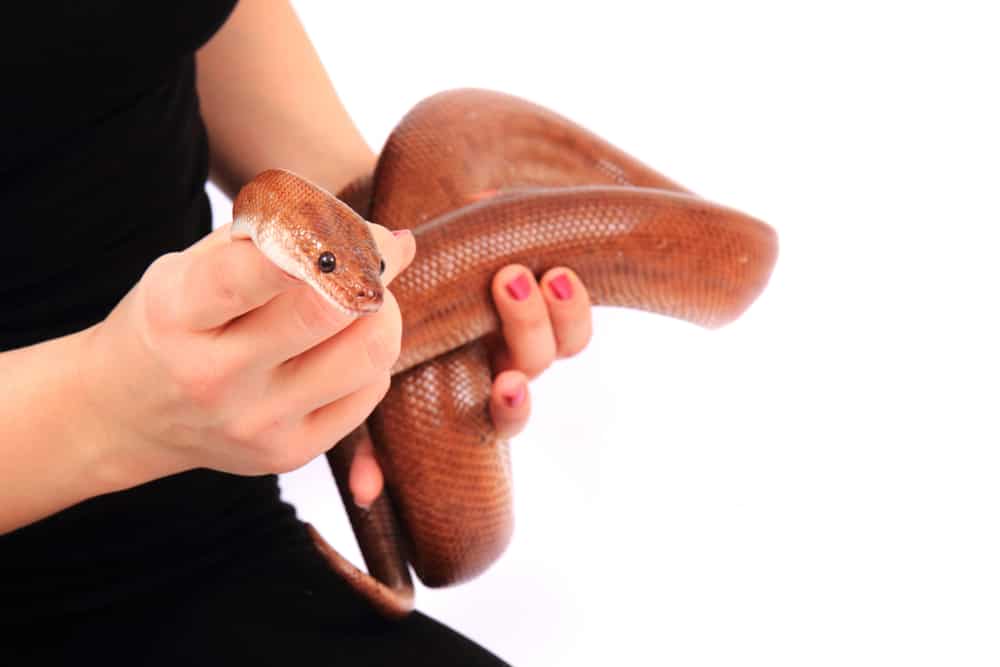
A baby Brazilian rainbow boa might be a bit nippy due to its shy nature.
Most keepers agree that, with regular handling, even the shyest rainbow boa hatchling will grow into a calm and docile adult.
An adult Brazilian rainbow boa that wasn’t socialized and handled from a young age might be far more aggressive, so adequate care is essential in this regard.
Black Brazilian Rainbow Boa
The Brazilian rainbow boa DOESN’T come in black. Thanks to confusion among different species, this is a popular misconception.
If you want a snake that combines the rainbow-colored effect with a black background, then you might want to look into a reticulated python with the Child’s gene.
There are many other rainbow-colored species as well, like the rainbow snake and the rainbow ball python.
Other Rainbow Boa Morphs
While the Brazilian rainbow boa might not come in black, there are more options than just brown.
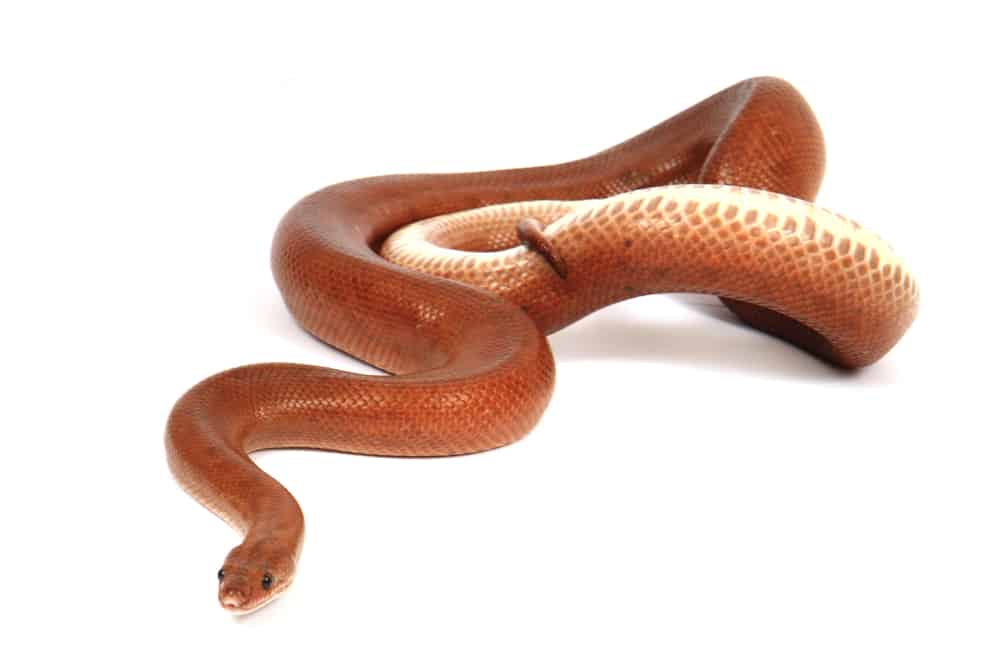
These snakes have various morphs that you can buy. They include:
- Albino – a morph that lacks all the pigments which give these animals color. They’re typically a light peach color. They retain the rainbow sheen since it’s not a pigment.
- Leucistic – this morph lacks certain pigments which makes it completely white. They typically have blue eyes.
- Hypo/Hypomelanistic – this morphs lacks some pigment types, which makes it seem faded compared to normal rainbow boas.
There are several other morphs of this species as well, and too many to cover comprehensively here.
We hope you’ve enjoyed this article about the species which people mistakenly refer to as black rainbow boas.
If you’re in the market for a boa, but unsure which one you want, check out some of our other boa-related articles. We have care sheets for the Kenyan Sand Boa, Arabian Sand Boa, and Rosy Boa.
If you’d like an arboreal snake, check out the article about the Amazon Tree Boa.
Alternatively, if you’d like to read about out a “rainbow” snake that does exist, check out our Colombian Rainbow Boa care sheet!
Would you buy a black rainbow boa if a breeder managed to produce one? Let us know in the comments.
